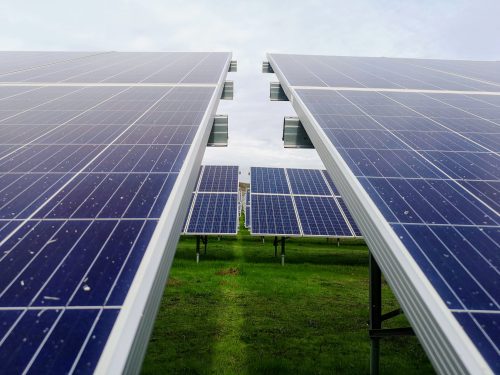Solar panels have become a common fixture of clean, renewable technology, providing energy from the sunlight rather than fossil fuels. These panels are covered in solar cells, which are made of semiconductormaterials that electrons can move through with relative ease. Solar energy can be collected from the photons themselves or the heat the sunlight generates; however, commercial solar panels largely use this first method.
When a photon of light hits a solar cell on a panel, that photon generates an exciton—an excited particle—in the active layer of a solar panel. Excitons are then separated and converted into a pair of charge carriers, particles that contain a pair of positive and negative charges. These charge carriers then produce the electricity used to power our homes, cell phones, and more.
Current solar panel models are both expensive to produce and relatively inaccessible to most consumers. Most solar panels only convert around fourteen percent of the solar power into usable energy. Fossil fuels, on the other hand, convert almost forty percent of their potential energy into usable energy. In principle, the ideal solar panel can be as efficient as thirty-three percent, but this limit has yet to be achieved. Thus, scientists have been searching for a new method to increase the maximum amount of energy collected and decrease the energy losses, resulting in a more efficient solar panel.
For researchers in the Campos research group at Columbia University’s Department of Chemistry and the Sfeir Research Group in CUNY’s Advanced Science Research Center, the answer lies in the materials that make up the panels. The researchers tried to develop materials that take in one photon and shoot out two excitons, which can then be converted to two pairs of charge carriers—increasing the current maximum threshold of energy efficiency by solar panels. Luckily, researchers had the tools to design the molecules of these materials, changing the active structure of the molecules and seeing how they interact with light and the charge currents to generate multiple excitons.
However, when tackling this problem, the researchers ran into a large issue: speed. “The two excitons nullify each other out so fast that you don’t get the chance to collect them,” Campos said. ‘Instead of collecting them in the solar panel to generate current, they recombine before becoming charge carriers.” Since the molecules recombine in just a few nanoseconds, the energy from the second pair of charge carriers cannot be used to increase solar panel yield, resulting in even more energy loss. The researchers had to look for a material that would allow the excitons to live for a much longer time, slowing the rate of recombination to a microsecond time scale. While this difference from nanoseconds to microseconds might seem inconsequentially small, the change increases the ability to collect the charge carriers. Ultimately, extending the lifespan of the excitons and charge carriers would allow for researchers to create a device to collect the energy from these particles and convert it into usable energy.
To solve this problem, the researchers looked at a variety of molecules and a variety of connections within the molecules. “We did a sequence of iterated studies to figure out chemically what is going to impact how the molecule interacts with the photons,” Campos said. “We would change the way the molecules are connected to see if our new hypothesis stands from previous ones.” The researchers would test one molecule, make a small change to the structure, and measure the response to light. Think of it as a puzzle; the researchers tried different shaped pieces to see which one fit best in the area they were trying to solve.
The researchers tested for patterns of responsiveness in three classes of molecules. Each class of molecule differed in how the active parts of the molecule were connected. The molecules in the third class were distinguished by an energy cleft between active areas. These molecules demonstrated the slowest rate of recombination—meaning that the exciton lifespan was longer. “After looking at all kinds of organic molecules over the years, this paper says if we put these molecular pieces together, then we should be able to get very long-lived excitons that can be converted to charge carriers,” Campos said.
The discovery of these molecules and the extended lifetime of charge carriers they induce is a breakthrough in solar panel technology. Prior to this work, the lifespans of multiple excitons were seen as very limited. “By giving them a longer lifetime in the active layer of your solar cell, we should be able to engineer a device to collect them and generate currents,” Campos said. “If you use these molecules, you can go up to a forty-four percent efficiency.”
However, the materials discovered by the researchers were only approached from a chemical perspective. “Once we put the molecules in a layer in an active device, what is the behavior going to look like?” Campos asked. Engineering ingenuity will be needed to turn these materials into a functioning solar panel. Since the materials were only tested chemically, the molecules have been looked at in isolation from each other and other components. However, in a device, each of the components work together to harness the energy. Thus, engineers will have to determine how these materials and the other components interact and synthesize them into a device that operates as one unit.
According to Campos, this will be a multidisciplinary team effort. Chemistry researchers need to work with engineers to implement the molecules to make devices and see how they actually work in a device. “We’ve been studying an individual person in an orchestra,” Campos said. Now, it is time that researchers look at the entire symphony.

